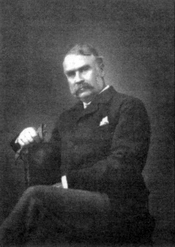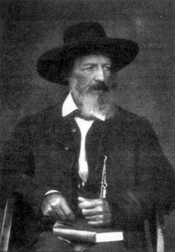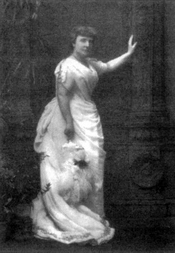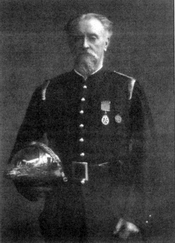|
The Barraud Family as Photographers
by John E. Rutherford
Part I
Every record collector knows Francis Barraudís
painting, "His Masterís Voice", but not so well known
is the fact that Francis was also a photographer, along
with other members of the Barraud family.
Recently, I purchased two volumes containing photos
taken at two of the Barraud Photographic Studios.
The volumes are dated 1888 and 1890, and both
volumes are titled "Men and Women of the Day".
Each volume contains about thirty-five mounted
studio photos, which appear to be printed from the
original negatives. All are in excellent condition and
are in sepia tones.
The mounting card for each photo measures
10" x 14" and the photo size is 7" x 9.5". Each photo is
followed by a four-page biography of the sitter,
written in flowery Victorian prose.
On the lower left-hand corner of each mounting
board the following words are printed:
"Barraud, 263 Oxford Street, London and 92 Bold Street,
Liverpool". The London studio was run by Herbert
Barraud, and Francis Barraud and his brother Philip
ran the Liverpool studio.
During the years covered by these two volumes
Nipper was living at the Liverpool address.
Unfortunately, he does not appear in any of the
photos.
Also unfortunately, there is no indication as to which
studio took which picture, or who clicked the shutter,
but whoever they were they did a professional job.
The photos are superb and the clientele was "top-
drawer".
Fig. 1
Lady Randolph Churchill

|
|
Fig. 2
W.S. Gilbert

|
|
Fig. 3
Alfred Lord Tennyson

|
|
Fig. 4
Frances Hodgson Burnett

|
|
Lady Randolph Churchill, Winstonís mother, stares
out at us with dark piercing eyes. (She was part
Iroquois.) (Fig. 1) W.S. Gilbert has an air of
confidence suitable to a man whose lyrics from
H.M.S. Pinafore and The Gondoliers were known by
nearly every person in the English-speaking
world. (Fig.2)
Alfred Lord Tennyson, Poet Laureate of England,
once described as "The Dirty Monk", appears as his
usual unkempt self. (Fig. 3) Tennyson came
from Lincolnshire, which is in the north of England
and near Liverpool, so it is quite possible that his
photo was taken at the Liverpool studio. The same
could be said for the Bishop of Liverpool who sports
a magnificent white beard.
Cardinals Manning and Newman are photographed
in old age, Newman being almost ninety and quite deaf.
He is pictured with his hand cupped behind his left
ear as if he were trying to catch instructions from the
photographer.
The world of the theatre is represented by, among
others, Henry Irving and his leading lady, Ellen Terry,
who later became one of George Bernard Shaw's
favourite actresses.
There are several musicians including Clara
Schumann and Dr. Hans Richter, along with singers
Sims Reeves, Charles Santley and Madame Roze.
(Both the latter two singers recorded, although
Madam Rozeís recordings have not been preserved as
far as I am aware. However, she was a very beautiful
woman, and George Bernard Shaw said that he would
go to the opera wearing earplugs just to see her walk
across the stage.)
Authors and poets include Robert Browning, H.
Rider-Haggard (King Solomonís Mines) and Frances
Hodgson Burnett, a huge woman who signed her
letters, "from your little sparrow" and who wrote
Little Lord Fauntleroy and The Little Princess. (Fig. 4)
Part II
The two photographic studios of the Barraud family,
Francis and Philip in Liverpool, and Herbert in
London, England, turned out an amazing group of
portraits of upper class society in the years 1888 to
1892. Some of the photos have Canadian
connections. The Earl of Dufferin became Canadaís
Governor General from 1872 to 1878. His wife, the
Countess of Dufferin, was a very talented woman.
She wrote a book called Canadian Journal, and she
was an excellent watercolour painter. The Barraud
portrait shows her resting her elbows on a standard
studio prop (Fig 5). The Canadians named a train
after her.
Major General Garnet Wolseley, who was sent to
Canada to face Louis Riel in the first Red River
Rebellion, is photographed in later middle age when
his former fame had been diminished. Gilbert and
Sullivan used him as their model for "a Modern Major
General" in The Pirates of Penzance (Fig. 6).
There is another photograph that has a Gilbert and
Sullivan connection. Captain Shaw was founder and
head of Londonís Fire Brigade. In the operetta,
lolanthe, the fairy queen, falls in love with a human
which was against the rules of Fairyland. She appeals
to the real Captain Shaw for help:
O, Captain Shaw!
Type of true love kept under!
Could thy brigade
With cold cascade,
Quench my true love, I wonder?
The Barraud photograph shows a rather shy man in
an ill-fitting uniform (Fig. 7).
Fig. 5
Countess of Dufferin

|
|
Fig. 6
Maj Gen Garnet Wolseley

|
|
Fig. 7
Captain Shaw

|
|
Fig. 8
W.G. Grace

|
|
The greatest name in the English sports world in the
1880s was that of W.G. Grace. He was the Babe Ruth
of English cricket, and some of his feats have never
been equalled. His beard was almost as famous as his
achievements (Fig. 8).
My two volumes of Barraud photographs are labelled
Volumes 1 and 3, and dated 1888 and 1890. The
University of Texas in Austin owns Volume 2 which
includes photos of Adeline Patti, the Shaw
of Persia, and W.H. Smith, the bookseller upon whom Gilbert
and Sullivan based their character, Sir Joseph Porter,
the Admiral of the Fleet in H.M.S. Pinafore. The
same University also has Volume 5, printed in 1892,
by which time famous people must have been getting
scarce. None of the sitters for that volume was known
to me. Volume 4 remains illusive. I wonder what
photos it contains ó Florence Nightingale? General
"Chinese" Gordon? Sir Arthur Sullivan? Lewis
Carroll? Sir Richard Burton?
Recently, I have seen several Barraud photographs
reproduced in newspapers, magazines and books, but
the Barraud name is nowhere to be seen. Instead,
"Bettmann Archives" and "Getty Images". The
Barraud name deserves to be better known, for not
only do these photos give us first-rate portraits of
English Society in the 1880s, but they also give
evidence of a lesser-known activity of the very
talented Barraud family.
|